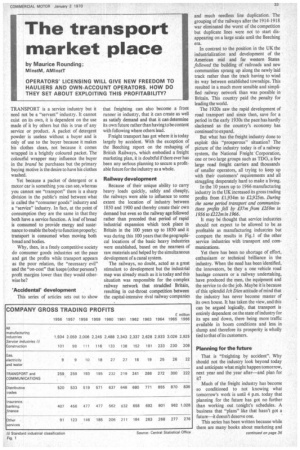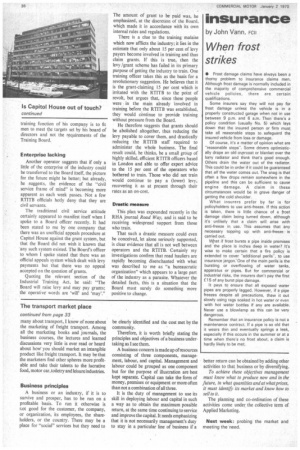The transport market place
Page 35

Page 38

If you've noticed an error in this article please click here to report it so we can fix it.
by Maurice Rounding; nstM, AMInstT OPERATORS' LICENSING WILL GIVE NEW FREEDOM TO HAULIERS AND OWN-ACCOUNT OPERATORS. HOW DO THEY SET ABOUT EXPLOITING THIS PROFITABILITY?
TRANSPORT is a service industry but it need not be a "servant" industry. It cannot exist on its own, it is dependent on the use made of it by others but this is true of any service or product. A packet of detergent powder is useless without a buyer and is only of use to the buyer because it makes his clothes clean, not because it comes wrapped in a brightly coloured packet. The colourful wrapper may influence the buyer in the brand he purchases but the primary buying motive is the desire to have his clothes washed.
Yet because a packet of detergent or a motor car is something you can see, whereas you cannot see "transport" there is a sharp division in the public's mind between what is called the "consumer goods" industry and a -serviceindustry. In fact, at the point of consumption they are the same in that they both have a service function. A loaf of bread is consumed to provide energy and suste, nance to enable the body to function properly; transport is consumed when moving both bread and bodies.
Why, then, in a freely competitive society do consumer goods industries set the pace and get the profits while transport appears as the poor relation, the -necessary evil" and the "on-cost" that keeps (other persons') profit margins lower than they would otherwise be?
that freighting can also become a front runner in industry, that it can create as well as satisfy demand and that it can determine its own future rather than having to be content with following where others lead.
Freight transport has got where it is today largely by accident. With the exception of the Beeching report on the reshaping of British Railways, which embodied a freight marketing plan, it is doubtful if there ever has been any serious planning to secure a profitable future for the industry as a whole.
Railway development
Because of their unique ability to carry heavy loads quickly, safely and cheaply, the railways were able to influence to some extent the location of industry between 1850 and 1900 and thereby create their own demand but even so the railway age followed rather than preceded that period of rapid industrial expansion which took place in Britain in the 100 years up to 1850 and it was during this 100 years that the geographical locations of the basic heavy industries were established, based on the nearness of raw materials and helped by the simultaneous development of a canal system.
The railways, no doubt, acted as a great stimulant to development but the industrial map was already much as it is today and this situation was responsible for the complex railway network that straddled Britain, resulting in cut-throat competition between the capital-intensive rival railway companies and much needless line duplication. The grouping of the railways after the 1914-1918 war eliminated the worst of the competition but duplicate lines were not to start disappearing on a large scale until the Beeching era.
In contrast to the position in the UK the industrialization and development of the American mid and far western States followed the building of railroads and new communities sprang up along the newly laid track rather than the track having to wind its way between established townships. This resulted in a much more sensible and simplified railway network than was possible in Britain. This country paid the penalty for leading the world.
The 1920s saw the rapid development of road transport and since then, save for a period in the early 1930s the pace has hardly slackened as the country's economy has continued to expand.
But what has the freight industry done to exploit this "prosperoussituation? The picture of the industry today is of a railway system, the National Freight Corporation, one or two large groups such as TDG, a few large road freight carriers and thousands of smaller operators, all trying to keep up with their customers' requirements and all struggling desperately hard to make a living.
In the 10 years up to 1966 manufacturing industry in the UK increased its gross trading profits from £1,934m to £2,925m. During the same period transport and communications profits fell by .1.37m from ,E259m in 1956 to £222m in 1966.
It may be thought that service industries should not expect to be allowed to be as profitable as manufacturing industries but compare the results in Fig.1 of the other service industries with transport and communications.
Yet there has been no shortage of effort, enthusiasm or technical brilliance in the industry. When the need has been identified, the innovators, be they a one vehicle road haulage concern or a railway undertaking, have produced the men, the equipment and the service to do the job. Maybe it is because of this splendid Ich Dien attitude of mind that the industry has never become master of its own house. It has taken the view, and this can be argued logically, that transport is entirely dependent on the state of industry for its ups and down, there being more traffic available in boom conditions and less in slump and therefore its prosperity is wholly tied to that of its customers.
Planning for the future
That is "freighting by accident". Why should not the industry look beyond today and anticipate what might happen tomorrow, next year and the year after—and plan for it?
Much of the freight industry has become so conditioned to not knowing what tomorrow's work is until 4 p.m. today that planning for the future has got no further than working out tonight's schedules. A business that "plans" like that hasn't got a future—it doesn't deserve one.
This series has been written because while there are many books about marketing and The transport market place continued from page 33 many about transport, I know of none about the marketing of freight transport. Among all the marketing books and journals, the business courses, the lectures and learned discussions very little is ever read or heard about how' you should market an intangible product like freight transport. It may be that the marketers find other spheres more profitable and take their talents to the lucrative food, motor car, toiletry and leisure industries.
Business principles A business or an industry, if it is to survive and prosper, has to be run on a profitable basis. To run it otherwise is not good for the customer, the company, or organization, its employees, the shareholders, or the country. There may be a place for "social" services but they need to be clearly identified and the cost met by the community.
Therefore, it is worth briefly stating the principles and objectives of a business undertaking as I see them.
A business concern is made up of resources consisting of three components, management, labour, and capital. Management and labour could be grouped as one component but for the purpose of illustration are best kept separate. Capital can take the form of money, premises or equipment or more often than not a combination of all three.
It is the duty of management to use its skill in deploying labour and capital in such a way as to obtain the maximum possible return, at the same time continuing to service and improve the capital. It needs emphasizing that it is not necessarily management's duty to stay in a particular line of business if a better return can be obtained by adding other activities to that business or by diversifying.
To achieve these objectives management must know what to produce now and in the future, in what quantities and at what prices, it must identify its market and know how to sell to II.
The planning and co-ordination of these activities come under the collective term of Applied Marketing.
Next week: probing the market and meeting the need.




















































































